Sustainable Exploration, Mining, and Utilization of a Rare Earth Deposit in Southeastern Guangxi: Insights into Metallogenic Regularity
Abstract
1. Introduction
2. Geological Background
3. Materials and Methods
4. Results
4.1. Characteristics of the Ore Body Distribution
4.2. Planar Distribution Characteristics of the Weathered Crust
4.3. Vertical Variation and Mineralization Characteristics of the Weathered Crust
4.4. Characteristics of the Rock Structure and Texture
4.5. The REE Enrichment Characteristics of the Granite Weathering Crust
4.6. Distribution Characteristics of Ore Types and Grades
5. Discussion
5.1. The Relationship Between Linear Features and Mineralization
5.2. Analysis of Metallogenic Regularity and Prospecting Direction
6. Conclusions
Author Contributions
Funding
Institutional Review Board Statement
Informed Consent Statement
Data Availability Statement
Acknowledgments
Conflicts of Interest
References
- Wu, K.; Yu, J.; Wang, J.; Li, X.; Wang, R.; Zhang, Z.; Xiao, C.; Chi, R. Recycle of residual ammonium from weathered crust elution-deposited rare earth tailings via an efficient combined method of elution, struvite precipitation, and on-line adsorption. J. Water Process Eng. 2024, 68, 106567. [Google Scholar] [CrossRef]
- Zhang, T.Q.; Zhang, M.K.; Zhou, F.; Feng, J.; Wu, X.Y.; Zhang, Y.X.; Zhang, L.S.; Yu, J.X.; Chi, R.A. Swelling suppression mechanism on the weathered crust elution-deposited rare earth ores leaching process with cetyltrimethylammonium bromide. Chem. Eng. Process.-Process Intensif. 2024, 205, 110014. [Google Scholar] [CrossRef]
- Deng, X.; Yu, D.; Xu, Y.; Hong, X.; Dong, W.; Chi, R.; Zhang, Z. Leaching process assisted by cetyltrimethylammonium chloride for weathered crust elution-deposited rare earth ores: Leaching behavior, kinetic analysis, and interfacial regulation. Colloids Surf. A Physicochem. Eng. Asp. 2024, 703, 135192. [Google Scholar] [CrossRef]
- Ou, J.C.; Peng, C.L.; Shi, X.M. Experimental study on mineral processing of an ion-adsorption rare earth ore in Guangxi, China. Chin. J. Rare Met. 2024, 45, 125–135. [Google Scholar]
- Guo, S.K.; Zhuang, F.Y. Lanthanum adsorption onto kaolinite: pH insensitivity behavior and competitive adsorption predictions through surface complexation models. Colloids Surf. A Physicochem. Eng. Asp. 2024, 700, 134598. [Google Scholar] [CrossRef]
- Yang, H.; Sha, A.; He, Z.; Wu, C.; Xu, Y.; Hu, J.; Xu, Z. Leaching kinetics and permeability of polyethyleneimine added ammonium sulfate on weathered crust elution-deposited rare earth ores. J. REEs 2024, 42, 1610–1619. [Google Scholar] [CrossRef]
- Wang, R.; Yu, J.; Chen, Y.; Li, X.; Zhang, Z.; Xiao, C.; Fang, Z.; Chi, R. The adsorption mechanism of NH4+ on clay mineral surfaces: Experimental and theoretical studies. Sep. Purif. Technol. 2023, 354, 128521. [Google Scholar] [CrossRef]
- Pan, J.; Zhao, L.; Li, Z.; Huang, X.; Feng, Z.; Chen, J. Occurrence and vertical distribution of aluminum and REEs in weathered crust elution-deposited rare earth ore: Effect of soil solution pH and clay minerals. J. REEs 2024, 42, 1394–1402. [Google Scholar]
- Yan, C.J. Study on the Mineralization Mechanism of Jiaping Rare Earth Deposit in Guangxi. Ph.D. Thesis, Guilin University of Technology, Guilin, China, 2024. [Google Scholar]
- Yin, J.; Zeng, D.; Tian, J.; Weng, Y. Mass transfer in heap leaching of weathered crust elution deposited rare earth ore with Al2(SO4)3 solution. J. REEs 2024, 42, 1175–1181. [Google Scholar] [CrossRef]
- Feng, J.; Wu, X.; Zhou, F.; Chi, R. Role of Calcium Chloride on the Eluting Process of Residual Ammonium from Weathered Crust Elution-Deposited Rare Earth Ore Tailings. Minerals 2024, 14, 521. [Google Scholar] [CrossRef]
- Fu, W.; Dong, C.F.; Xu, C.; Wang, R.; Lu, J.; Zhou, H.; Han, Z.; Yi, Y.; Lv, Y.; Huang, G.; et al. Breakthrough directions in prospecting for ion-adsorption type heavy REE deposits in Guangxi and progress in scientific demonstration and exploration. Earth Sci. 2024, 49, 1931–1945. [Google Scholar]
- Yang, H.F.; Sha, A.Y.; He, Z.Y.; Wu, M.; Qu, J.; Wu, C.J.; Xu, Z.G.; Chi, R.A. Swelling inhibition and infiltration promotion mechanism of polyethyleneimine. J. Cent. South Univ. 2024, 31, 317–329. [Google Scholar] [CrossRef]
- Wu, X.; Feng, J.; Zhou, F.; Liu, C.; Chi, R. Optimization of a Rare Earth and Aluminum Leaching Process from Weathered Crust Elution-Deposited Rare Earth Ore with Surfactant CTAB. Minerals 2024, 14, 321. [Google Scholar] [CrossRef]
- Zhang, Q.T. Composite inhibitor and its mechanism for the flotation separation of rare earth and calcium-barium minerals. Miner. Prot. Util. 2024, 44, 6. [Google Scholar]
- Deng, J.; Zhan, M.G.; Zhou, W.J. Distribution patterns and potential assessment of mineral resources in Guangxi, China. Miner. Depos. 2023, 42, 1048–1073. [Google Scholar] [CrossRef]
- Ban, Y.Y. Optimization Research on Quantitative Remote Sensing Prediction Model of Ion-Adsorption REE Deposits Based on GF-2 Images. Ph.D. Thesis, Central South University, Changsha, China, 2023. [Google Scholar]
- Chen, W.; Zhang, Z.; Long, F.; Chen, Z.; Chi, R. Rare Earth Occurrence States of Weathered Crust Elution-Deposited Rare Earth Ores in Southern Yunnan. Minerals 2023, 13, 554. [Google Scholar] [CrossRef]
- Gan, L.; Yan, B.; Liu, Y.; Gao, Y.; Yin, C.; Zhu, L.; Tan, S.; Ding, D.; Jiang, H. Geochemical and Mineralogical Characteristics of Ion-Adsorption Type REE Mineralization in the Mosuoying Granite, Panxi Area, Southwest China. Minerals 2023, 13, 1449. [Google Scholar] [CrossRef]
- Xu, Z.; Li, G.; Yang, H.; Sha, A.; He, Z.; Tang, Y.; Wu, M.; Qu, J. Development Review on Leaching Technology and Leaching Agents of Weathered Crust Elution-Deposited Rare Earth Ores. Minerals 2023, 13, 1223. [Google Scholar] [CrossRef]
- Feng, J.; Wu, X.; Gao, Z. Leaching Behavior of REEs and Aluminum from Weathered Crust Elution-Deposited Rare Earth Ore with Ammonium Formate Inhibitor. Minerals 2023, 13, 940. [Google Scholar] [CrossRef]
- Zhang, Z.; Zhou, C.; Chen, W.; Long, F.; Chen, Z.; Chi, R. Effects of Ammonium Salts on Rare Earth Leaching Process of Weathered Crust Elution-Deposited Rare Earth Ores. Metals 2023, 13, 1112. [Google Scholar] [CrossRef]
- Liang, X.; Liang, C.; Qian, L. Characteristics and genetic understanding of ion adsorption REE deposits in Southeast Guangxi—Taking a rare earth deposit in Beiliu as an example. J. Depos. Geol. 2014, 33, 1179–1180. [Google Scholar]
- Lan, Q.; Lin, J.; Fu, S.; Luo, J. Cathodoluminescent textures and trace element signatures of hydrothermal quartz from the granite-related No.302 uranium deposit, South China: A reconnaissance study for their genetic significances. J. Geochem. Explor. 2021, 224, 106740. [Google Scholar] [CrossRef]
- Qian, L.; Lai, J.; Hu, L.; Cao, R.; Tao, S.; You, B. Geochronology and Geochemistry of the Granites from the Longtoushan Hydrothermal Gold Deposit in the Dayaoshan Area, Guangxi: Implication for Petrogenesis and Mineralization. J. Earth Sci. 2019, 30, 309–322. [Google Scholar] [CrossRef]
- Xin, Y. Analysis of ore quality characteristics of rare earth ore in the South ore section of Huashan mining area, Zhongshan County, Guangxi. J. Miner. Geol. 2019, 33, 790–799+807. [Google Scholar]
- Keith, M.; Smith, D.J.; Jenkin, G.R.; Holwell, D.A.; Dye, M.D. A review of Te and Se systematics in hydrothermal pyrite from precious metal deposits: Insights into ore-forming processes. Ore Geol. Rev. 2018, 96, 269–282. [Google Scholar] [CrossRef]
- Fougerouse, D.; Micklethwaite, S.; Ulrich, S.; Miller, J.; Godel, B.; Adams, D.T.; McCuaig, T.C. Evidence for Two Stages of Mineralization in West Africa’s Largest Gold Deposit: Obuasi, Ghana. Econ. Geol. 2017, 112, 3–22. [Google Scholar] [CrossRef]
- Wang, Z. Study on Metallogenic Mechanism of Miaoershan Granite Type Uranium Deposit in Guangxi. Ph.D. Thesis, Beijing Institute of Geology of Nuclear Industry, Beijing, China, 2018; p. 122. [Google Scholar]
- Zhao, K. Hf isotopic composition of zircon microregions of Huashan Guposhan intrusive complex and dark inclusions in northeastern Guangxi and its diagenetic significance. J. Sci. Bull. 2009, 54, 3716–3725+3794–3795. [Google Scholar]
- Pašava, J.; Kříbek, B.; Dobeš, P.; Vavřín, I.; Žák, K.; Delian, F.; Tao, Z.; Boiron, M.C. Tin–polymetallic sulfide deposits in the eastern part of the Dachang tin field (South China) and the role of black shales in their origin. Miner. Depos. 2002, 38, 39–66. [Google Scholar] [CrossRef]
- Wang, T.; Li, G.; Wang, Q.; Santosh, M.; Zhang, Q.; Deng, J. Petrogenesis and metallogenic implications of Late Cretaceous I-and S-type granites in Dachang–Kunlunguan ore belt, southwestern South China Block. Ore Geol. Rev. 2019, 113, 103079. [Google Scholar] [CrossRef]
- Zhu, W.; Fu, Y. Present situation, problems and suggestions on the development and utilization of REE resources in China—A case study of Bayan Obo mine and Mianning mine, an ionic adsorption mine in seven provinces in the South. J. Shandong Land Resour. 2015, 31, 31–35+39. [Google Scholar]
- Launay, G.; Sizaret, S.; Guillou-Frottier, L.; Gloaguen, E.; Pinto, F. Deciphering fluid flow at the magmatic-hydrothermal transition: A case study from the world-class Panasqueira W–Sn–(Cu) ore deposit (Portugal). Earth Planet. Sci. Lett. 2018, 499, 1–12. [Google Scholar] [CrossRef]
- Hu, Z.; Feng, M. Symbiotic enrichment characteristics and genesis of ilmenite and rare earth in igneous weathering crust in Southeast Guangxi. J. Rare Earth 2019, 40, 16–27. [Google Scholar]
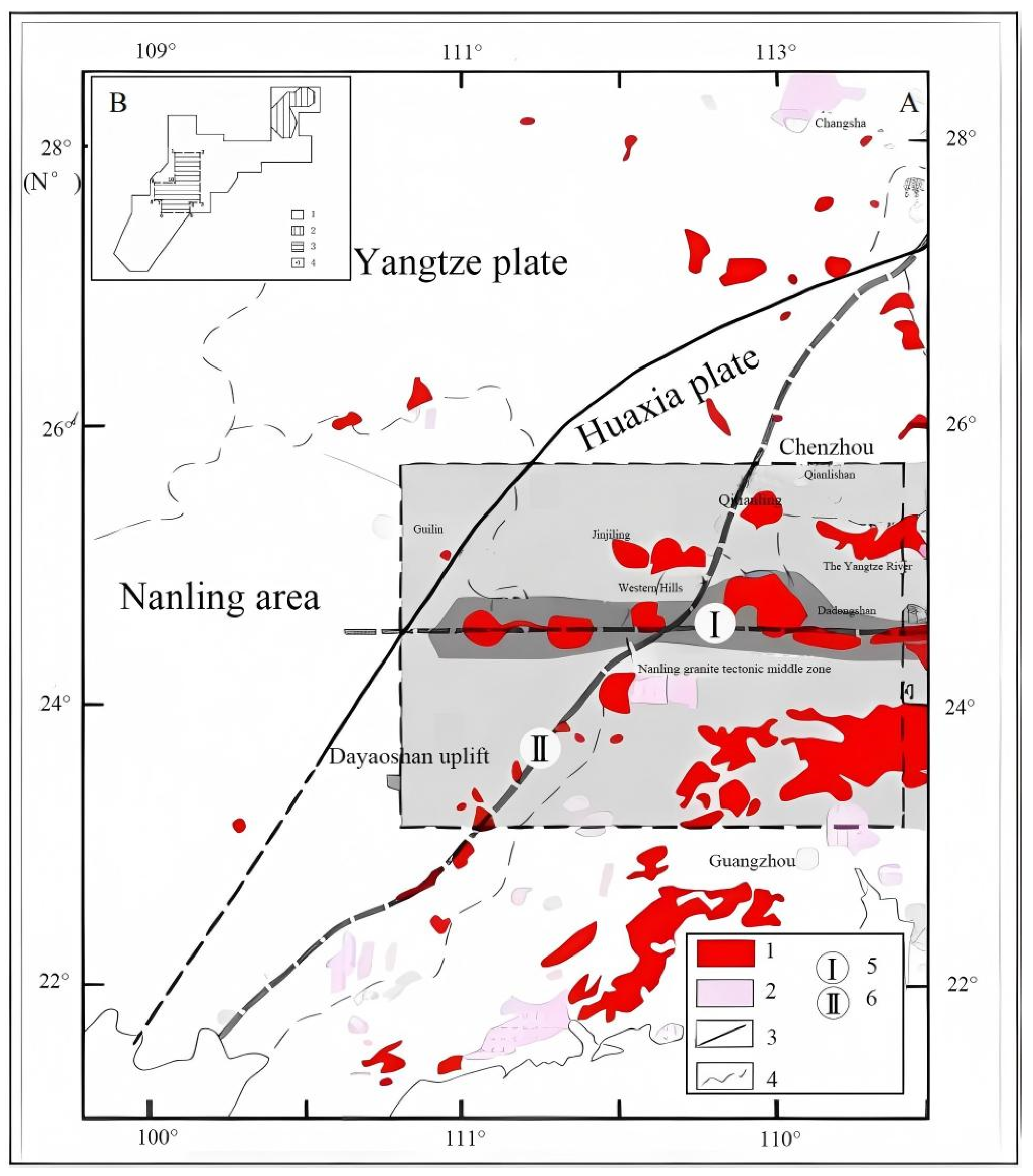
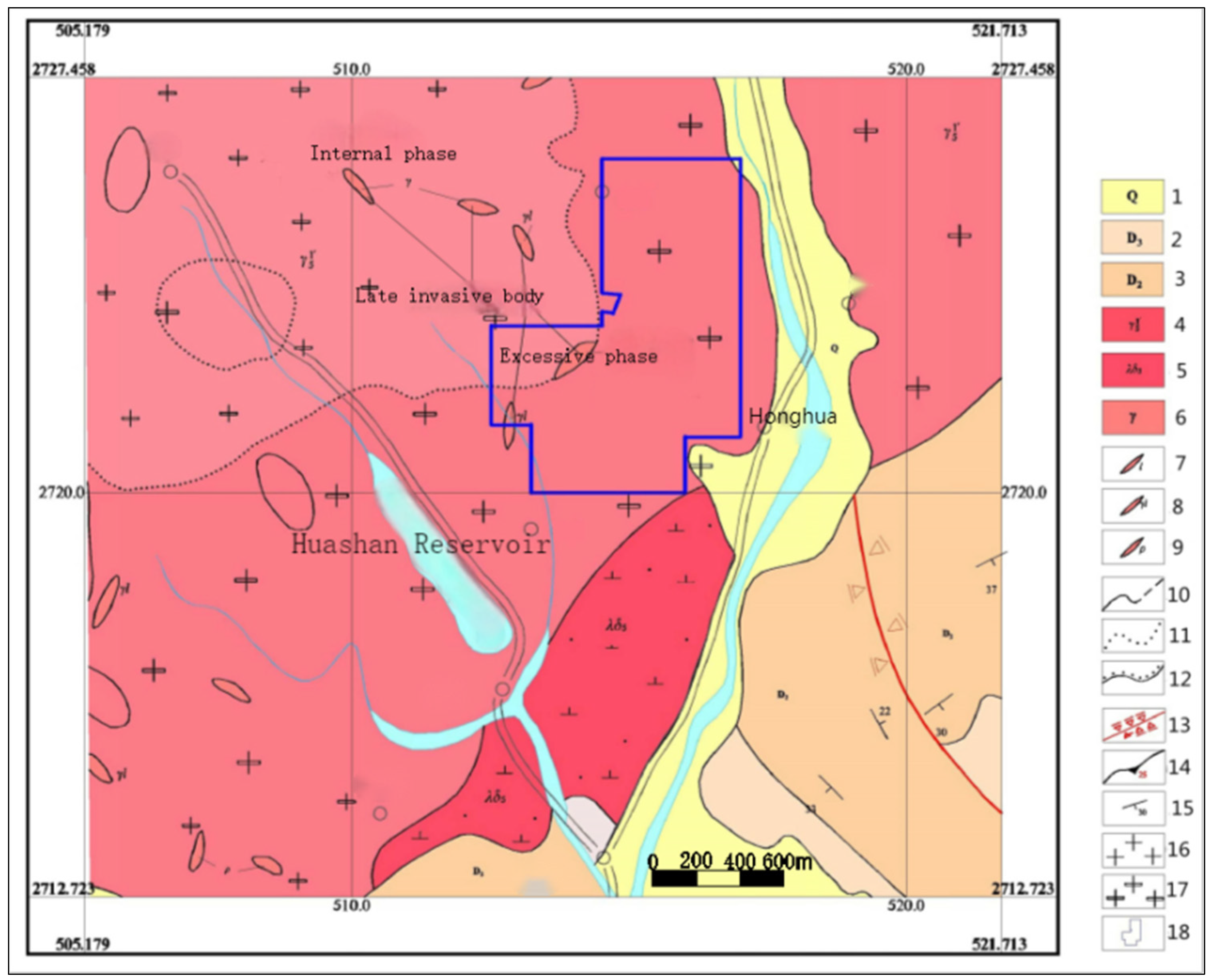
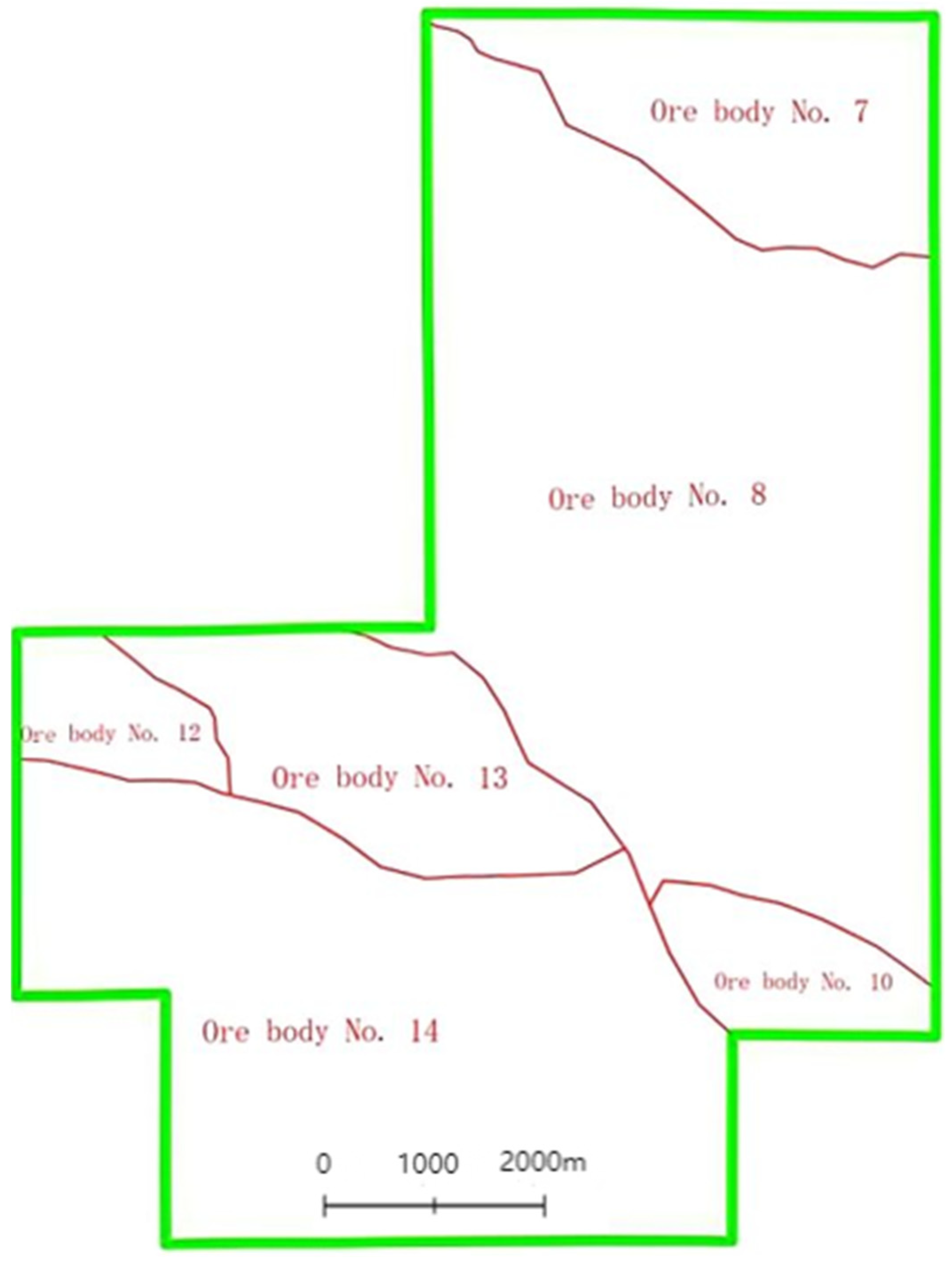
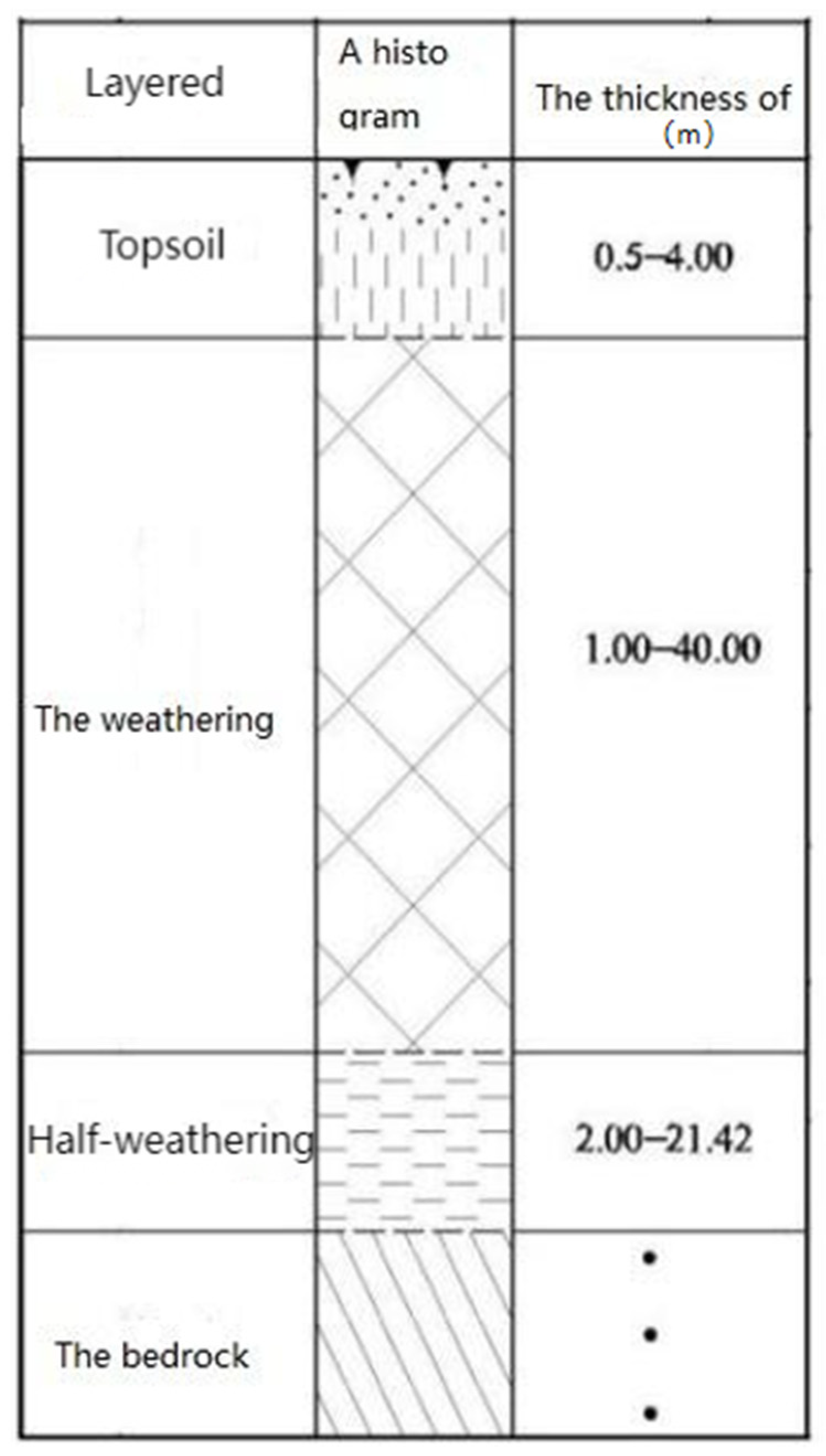
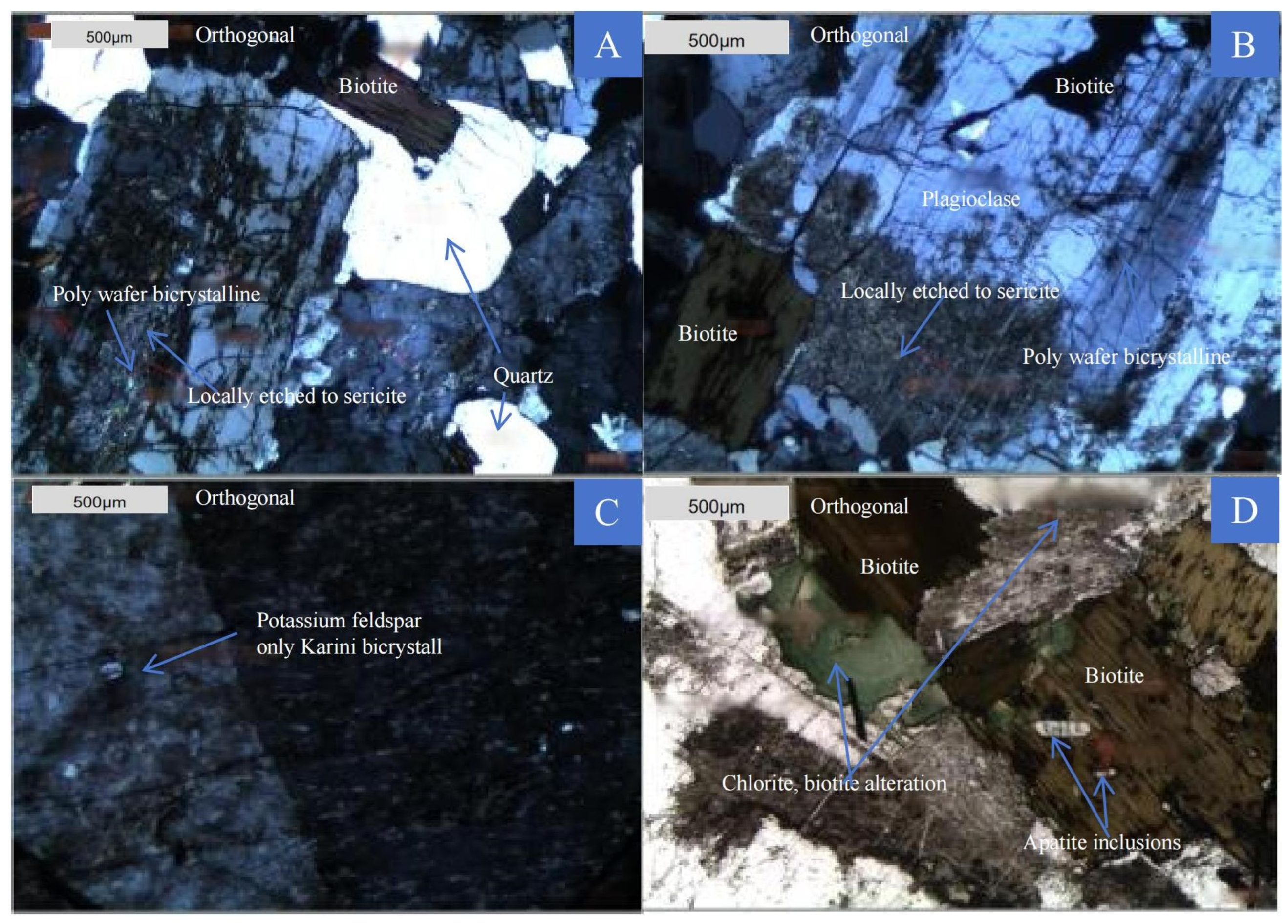
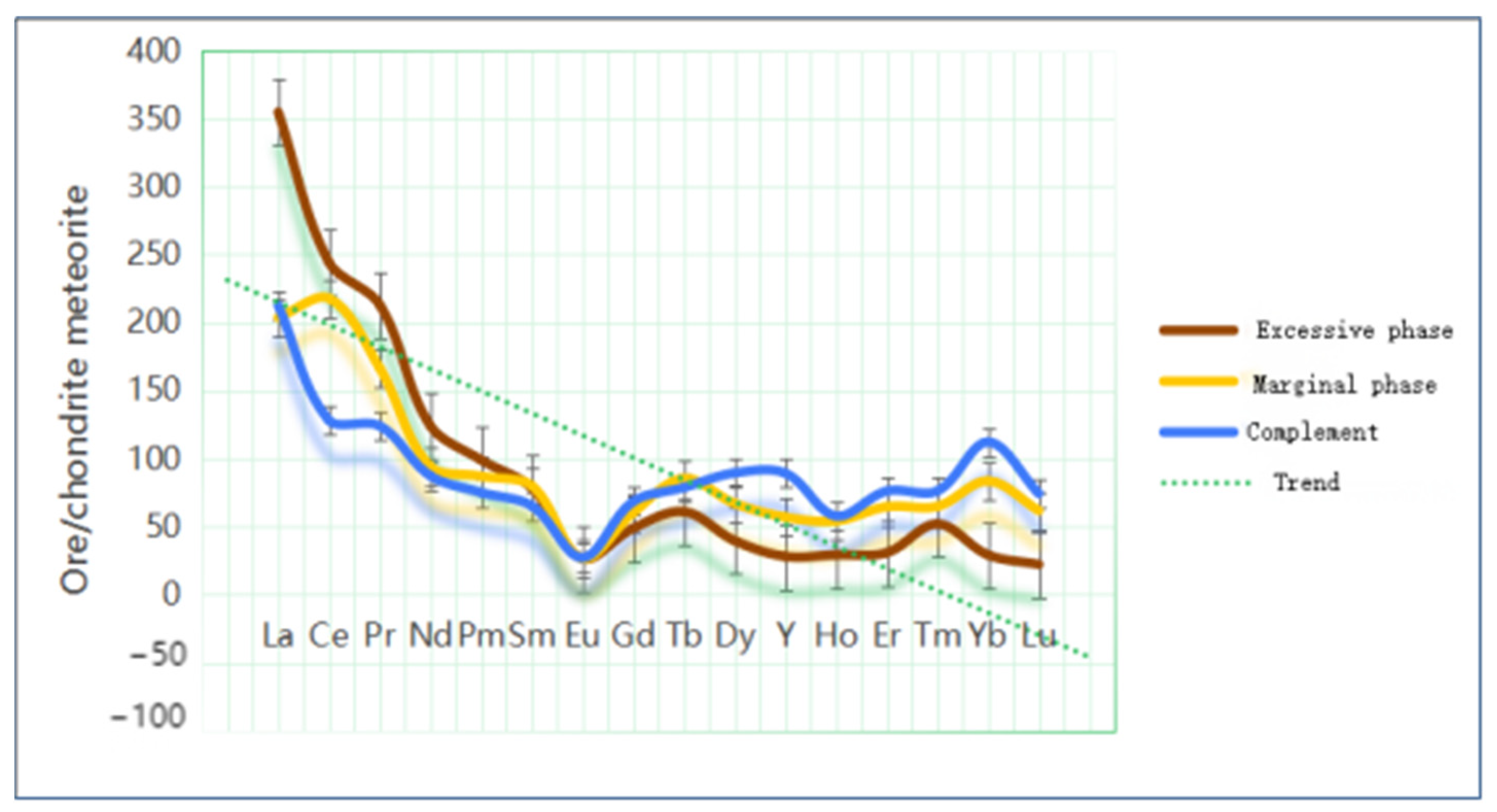


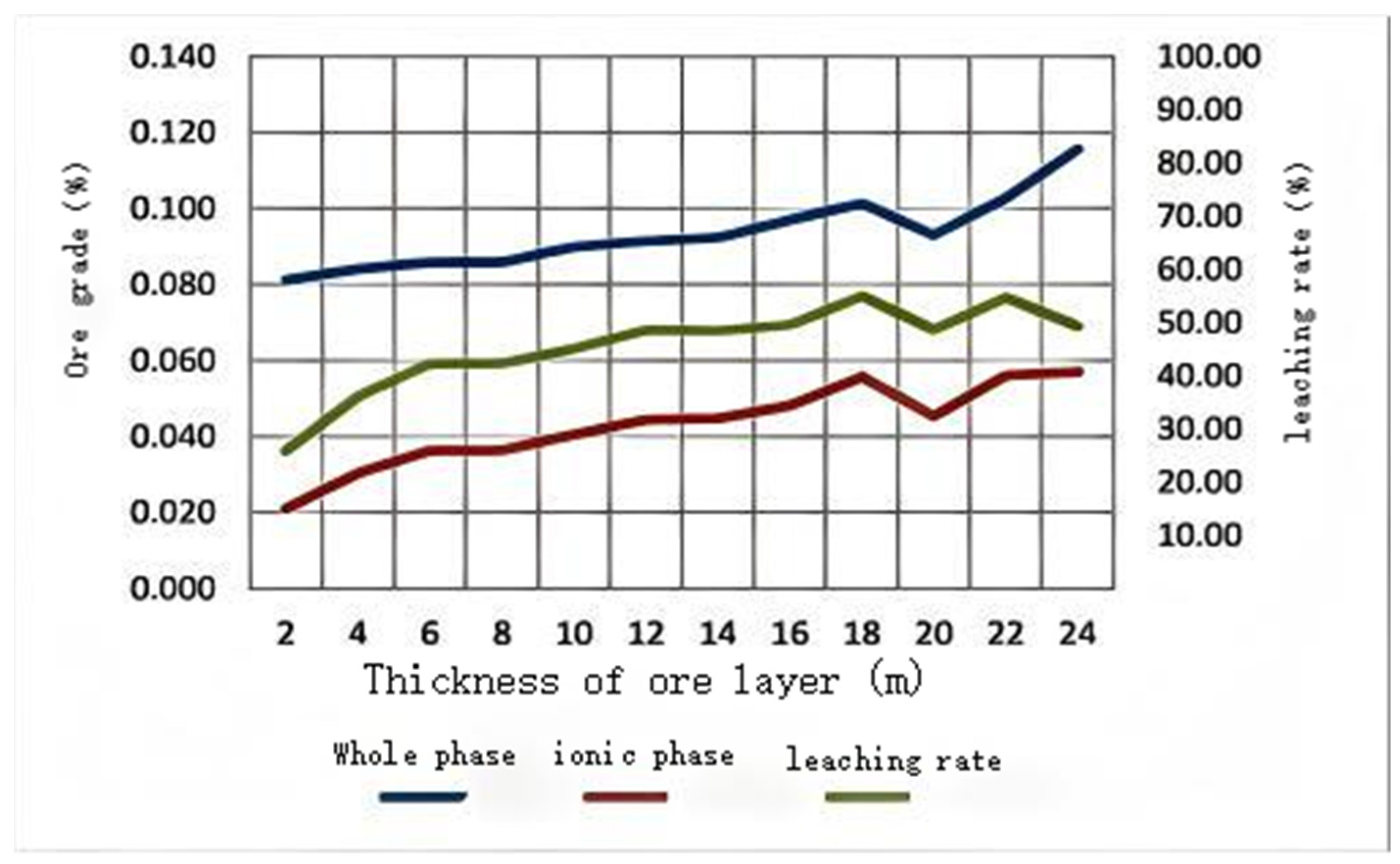
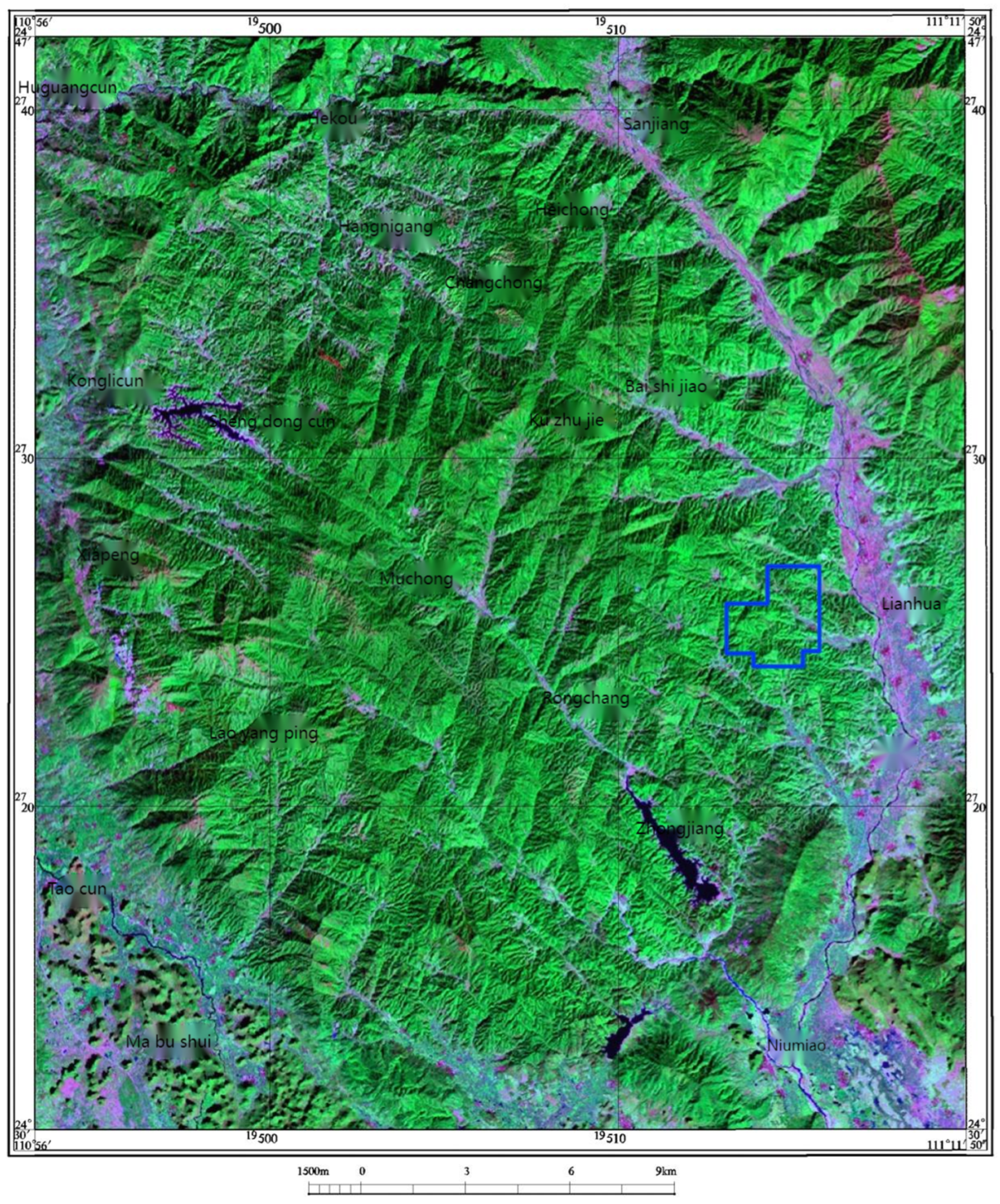
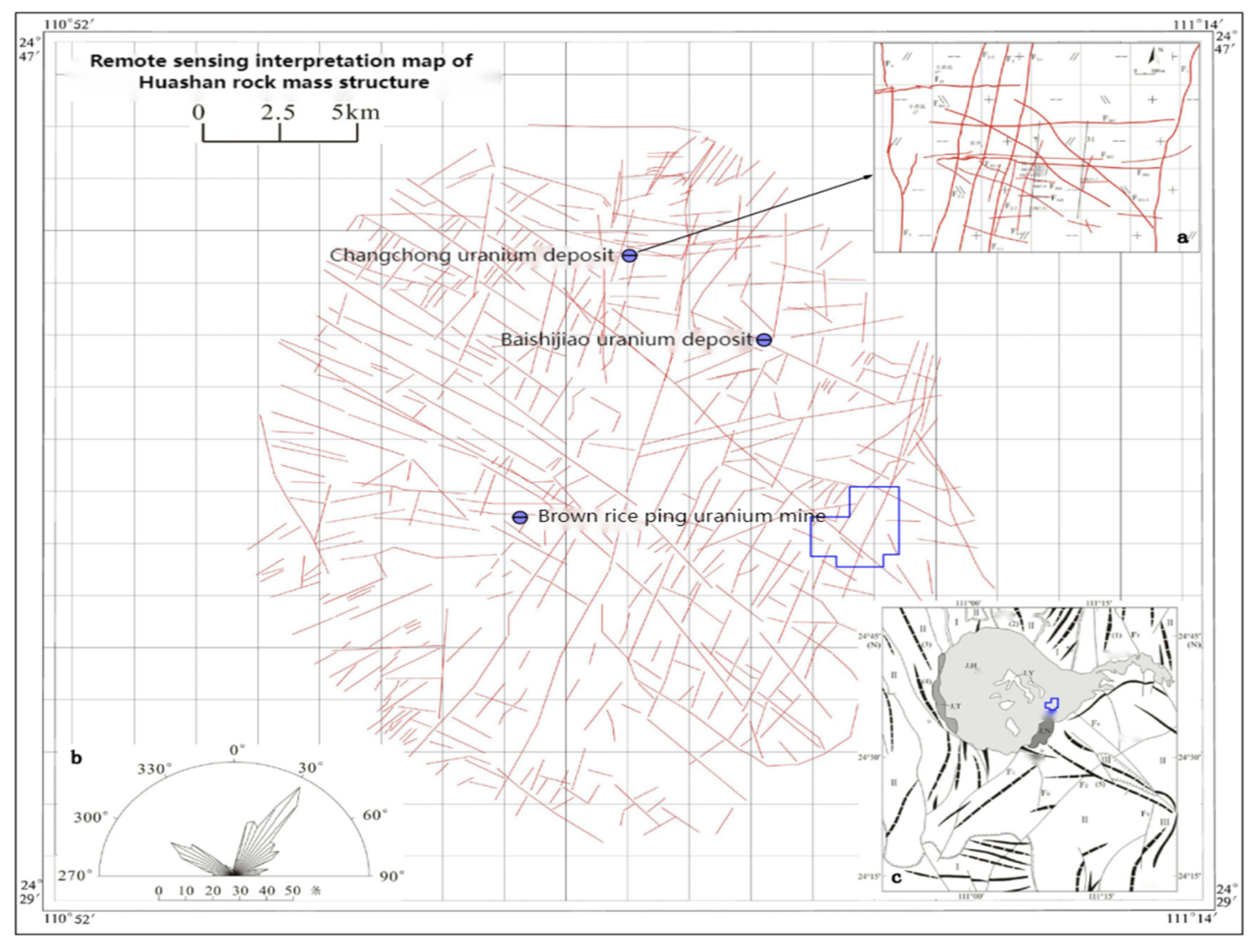

| Sample Number | Analysis Result ωB/10−6 | Notes | |||||||||||||||
|---|---|---|---|---|---|---|---|---|---|---|---|---|---|---|---|---|---|
| La2O3 | CeO2 | Pr6O11 | Nd2O3 | Sm2O3 | Eu2O3 | Y2O3 | Gd2O3 | Tb4O7 | Dy2O3 | Ho2O3 | Er2O3 | Tm2O3 | Yb2O3 | Lu2O3 | REO | ||
| ZH01 | 179.60 | 211.80 | 36.11 | 122.30 | 22.47 | 3.22 | 123.20 | 20.50 | 3.65 | 19.15 | 3.76 | 10.18 | 1.89 | 10.65 | 1.55 | 770.04 | Ore |
| ZH02 | 180.90 | 187.40 | 37.29 | 123.50 | 22.27 | 2.63 | 103.90 | 18.37 | 3.14 | 16.44 | 3.21 | 8.86 | 1.68 | 9.58 | 1.40 | 720.56 | |
| ZH03 | 183.20 | 205.40 | 36.60 | 124.10 | 23.07 | 2.90 | 125.00 | 20.37 | 3.70 | 19.87 | 3.83 | 10.16 | 1.87 | 10.21 | 1.52 | 771.79 | |
| ZH04 | 188.60 | 200.60 | 36.99 | 123.10 | 22.94 | 2.84 | 132.90 | 20.57 | 3.88 | 20.74 | 4.10 | 11.14 | 2.07 | 11.56 | 1.69 | 783.71 | |
| ZH05 | 164.90 | 217.60 | 32.97 | 110.50 | 20.79 | 2.43 | 100.80 | 17.35 | 3.09 | 16.57 | 3.21 | 8.86 | 1.67 | 9.61 | 1.40 | 711.74 | |
| ZH06 | 207.80 | 211.70 | 42.19 | 141.60 | 25.48 | 3.18 | 133.60 | 21.73 | 3.83 | 20.58 | 4.17 | 11.48 | 2.29 | 13.09 | 1.92 | 844.64 | |
| ZH07 | 137.40 | 186.40 | 27.40 | 91.86 | 16.28 | 1.93 | 87.69 | 13.89 | 2.46 | 13.09 | 2.66 | 7.45 | 1.43 | 8.15 | 1.19 | 599.29 | |
| ZH08 | 137.40 | 213.20 | 27.29 | 91.36 | 16.39 | 1.99 | 85.39 | 14.58 | 2.49 | 13.37 | 2.64 | 7.06 | 1.41 | 7.92 | 1.18 | 623.66 | |
| ZH09 | 166.90 | 215.80 | 33.19 | 111.10 | 19.81 | 2.50 | 109.30 | 17.64 | 3.22 | 17.02 | 3.44 | 9.56 | 1.81 | 10.61 | 1.53 | 723.43 | |
| ZH10 | 179.20 | 224.00 | 35.89 | 119.80 | 22.17 | 2.79 | 119.80 | 19.72 | 3.49 | 19.13 | 3.76 | 10.33 | 1.99 | 11.38 | 1.64 | 775.09 | |
| ZH11 | 179.70 | 240.60 | 36.07 | 120.30 | 21.62 | 2.69 | 107.00 | 19.19 | 3.28 | 17.22 | 3.38 | 9.42 | 1.75 | 10.02 | 1.46 | 773.71 | |
| ZH12 | 170.90 | 216.30 | 34.18 | 114.10 | 21.62 | 2.66 | 118.60 | 18.92 | 3.40 | 18.30 | 3.67 | 10.10 | 1.94 | 11.20 | 1.65 | 747.52 | |
| ZH13 | 158.50 | 218.80 | 31.26 | 103.40 | 17.94 | 2.07 | 88.41 | 15.11 | 2.48 | 13.37 | 2.65 | 7.53 | 1.46 | 8.64 | 1.24 | 672.86 | |
| ZH14 | 199.70 | 205.20 | 38.97 | 127.90 | 22.80 | 2.69 | 117.70 | 19.42 | 3.32 | 17.87 | 3.57 | 9.86 | 1.94 | 11.16 | 1.66 | 783.76 | |
| ZH15 | 150.50 | 197.30 | 30.28 | 101.80 | 18.06 | 2.04 | 106.50 | 16.08 | 2.91 | 15.85 | 3.18 | 8.97 | 1.79 | 10.43 | 1.57 | 667.26 | |
| ZH16 | 179.00 | 210.60 | 36.05 | 120.80 | 22.09 | 2.57 | 120.20 | 19.06 | 3.39 | 18.28 | 3.74 | 10.44 | 2.11 | 11.96 | 1.81 | 762.09 | |
| ZH17 | 171.50 | 214.60 | 33.84 | 112.90 | 20.25 | 2.43 | 103.40 | 17.68 | 3.04 | 16.14 | 3.25 | 9.20 | 1.76 | 10.33 | 1.54 | 721.85 | |
| ZH18 | 183.20 | 212.40 | 36.93 | 122.60 | 22.12 | 2.47 | 110.70 | 18.42 | 3.28 | 17.53 | 3.43 | 9.63 | 1.87 | 10.85 | 1.62 | 757.05 | |
| ZH19 | 170.80 | 196.40 | 34.88 | 117.60 | 21.26 | 2.38 | 117.60 | 18.42 | 3.32 | 17.67 | 3.58 | 9.71 | 1.99 | 11.31 | 1.68 | 728.60 | |
| ZH20 | 198.60 | 236.80 | 40.91 | 136.10 | 24.17 | 2.85 | 123.60 | 20.91 | 3.65 | 19.60 | 3.86 | 10.75 | 2.13 | 12.23 | 1.79 | 837.95 | |
| ZH21 | 175.30 | 228.80 | 36.13 | 119.70 | 21.68 | 2.48 | 108.00 | 18.57 | 3.15 | 16.88 | 3.40 | 9.48 | 1.83 | 10.75 | 1.58 | 757.72 | |
| ZH22 | 144.70 | 226.40 | 29.92 | 100.00 | 18.03 | 2.08 | 87.60 | 15.86 | 2.66 | 14.11 | 2.82 | 7.84 | 1.52 | 8.84 | 1.28 | 663.66 | |
| ZH23 | 161.10 | 231.20 | 32.90 | 110.80 | 20.07 | 2.33 | 108.10 | 17.51 | 3.10 | 16.53 | 3.33 | 9.57 | 1.83 | 10.82 | 1.54 | 730.73 | |
| ZH24 | 165.50 | 220.50 | 33.74 | 114.40 | 20.63 | 2.62 | 103.40 | 17.80 | 3.17 | 16.57 | 3.32 | 9.16 | 1.77 | 10.15 | 1.46 | 724.17 | |
| ZH25 | 169.20 | 214.40 | 34.44 | 117.60 | 20.80 | 2.62 | 103.10 | 17.90 | 3.06 | 16.09 | 3.20 | 8.85 | 1.67 | 9.63 | 1.41 | 723.98 | |
| ZH26 | 144.80 | 215.00 | 30.03 | 101.10 | 18.23 | 2.21 | 97.70 | 16.11 | 2.74 | 15.09 | 2.95 | 8.35 | 1.59 | 9.18 | 1.41 | 666.48 | |
| ZH01 | 106.40 | 29.40 | 21.62 | 68.34 | 12.40 | 1.76 | 81.33 | 14.30 | 2.19 | 11.52 | 2.38 | 6.69 | 0.88 | 5.10 | 0.70 | 365.01 | Mixed initial products |
| ZH02 | 131.60 | 30.50 | 27.07 | 84.81 | 14.94 | 1.74 | 72.05 | 14.91 | 2.22 | 11.16 | 2.19 | 6.04 | 0.78 | 4.58 | 0.63 | 405.20 | |
| ZH03 | 141.30 | 36.50 | 28.79 | 91.31 | 17.20 | 2.16 | 97.84 | 18.56 | 2.89 | 15.16 | 3.01 | 8.24 | 1.04 | 6.18 | 0.83 | 470.99 | |
| ZH04 | 138.80 | 31.05 | 27.13 | 84.60 | 15.63 | 1.84 | 99.76 | 17.50 | 2.79 | 14.79 | 3.00 | 8.38 | 1.05 | 6.17 | 0.86 | 453.35 | |
| ZH05 | 89.17 | 28.69 | 18.45 | 57.77 | 10.32 | 1.09 | 55.44 | 10.59 | 1.61 | 8.40 | 1.65 | 4.55 | 0.58 | 3.45 | 0.47 | 292.22 | |
| ZH06 | 124.90 | 24.09 | 25.01 | 77.49 | 13.72 | 1.76 | 84.08 | 15.14 | 2.23 | 11.99 | 2.47 | 7.11 | 0.94 | 5.57 | 0.78 | 397.28 | |
| ZH07 | 81.57 | 25.06 | 16.84 | 52.49 | 9.12 | 1.01 | 57.26 | 9.40 | 1.45 | 7.95 | 1.62 | 4.54 | 0.60 | 3.49 | 0.48 | 272.86 | |
| ZH08 | 62.96 | 23.19 | 13.11 | 40.69 | 7.22 | 0.70 | 44.13 | 7.69 | 1.15 | 6.13 | 1.22 | 3.36 | 0.42 | 2.42 | 0.33 | 214.70 | |
| ZH09 | 94.13 | 24.04 | 19.03 | 59.40 | 10.71 | 1.24 | 70.41 | 11.61 | 1.81 | 9.93 | 2.02 | 5.80 | 0.76 | 4.59 | 0.63 | 316.11 | |
| ZH10 | 100.60 | 20.01 | 20.04 | 62.20 | 11.00 | 1.31 | 71.59 | 11.83 | 1.78 | 9.57 | 1.98 | 5.50 | 0.69 | 3.92 | 0.54 | 322.56 | |
| ZH11 | 101.30 | 22.67 | 20.10 | 62.14 | 11.03 | 1.27 | 65.96 | 11.75 | 1.76 | 9.55 | 1.90 | 5.36 | 0.70 | 4.08 | 0.56 | 320.12 | |
| ZH12 | 113.70 | 27.05 | 22.95 | 71.95 | 12.97 | 1.64 | 82.62 | 14.03 | 2.20 | 11.83 | 2.43 | 6.90 | 0.90 | 5.36 | 0.73 | 377.26 | |
| ZH13 | 94.04 | 23.94 | 19.26 | 59.59 | 10.09 | 1.14 | 58.53 | 10.13 | 1.54 | 8.41 | 1.75 | 4.95 | 0.66 | 4.08 | 0.55 | 298.65 | |
| ZH14 | 136.70 | 19.20 | 26.23 | 81.02 | 14.08 | 1.80 | 81.22 | 14.86 | 2.24 | 11.98 | 2.48 | 7.14 | 0.95 | 5.61 | 0.78 | 406.28 | |
| ZH15 | 99.44 | 24.94 | 20.20 | 62.92 | 11.34 | 1.21 | 76.13 | 11.94 | 1.94 | 10.75 | 2.25 | 6.52 | 0.89 | 5.56 | 0.74 | 336.76 | |
| ZH16 | 112.30 | 21.17 | 22.36 | 69.27 | 12.28 | 1.44 | 83.41 | 13.04 | 2.06 | 11.33 | 2.38 | 6.95 | 0.95 | 5.75 | 0.80 | 365.49 | |
| ZH17 | 91.25 | 21.16 | 17.78 | 54.06 | 9.35 | 1.03 | 57.22 | 9.62 | 1.45 | 7.86 | 1.62 | 4.58 | 0.60 | 3.54 | 0.49 | 281.61 | |
| ZH18 | 140.30 | 25.15 | 27.24 | 83.34 | 14.58 | 1.69 | 78.24 | 14.33 | 2.24 | 12.06 | 2.44 | 7.08 | 0.95 | 5.65 | 0.80 | 416.08 | |
| ZH19 | 118.00 | 21.06 | 24.04 | 74.60 | 13.59 | 1.51 | 82.22 | 13.87 | 2.14 | 11.46 | 2.34 | 6.74 | 0.90 | 5.42 | 0.74 | 378.61 | |
| ZH20 | 114.60 | 21.54 | 23.08 | 73.06 | 12.56 | 1.48 | 73.95 | 12.71 | 1.95 | 10.49 | 2.19 | 5.99 | 0.83 | 5.06 | 0.70 | 360.19 | |
| ZH21 | 89.00 | 25.29 | 18.49 | 57.19 | 9.99 | 1.09 | 58.49 | 10.37 | 1.57 | 8.55 | 1.75 | 5.01 | 0.68 | 4.04 | 0.56 | 292.07 | |
| ZH22 | 73.11 | 25.80 | 14.97 | 46.77 | 8.08 | 0.82 | 47.44 | 8.30 | 1.26 | 6.94 | 1.39 | 3.90 | 0.52 | 2.97 | 0.41 | 242.66 | |
| ZH23 | 86.91 | 24.21 | 17.82 | 55.12 | 9.72 | 1.09 | 64.47 | 10.23 | 1.60 | 8.97 | 1.84 | 5.33 | 0.71 | 4.31 | 0.58 | 292.92 | |
| ZH24 | 96.69 | 28.37 | 19.58 | 61.61 | 11.11 | 1.26 | 64.90 | 11.18 | 1.71 | 9.26 | 1.87 | 5.29 | 0.71 | 4.11 | 0.57 | 318.22 | |
| ZH25 | 103.20 | 21.94 | 20.93 | 64.91 | 11.28 | 1.38 | 65.32 | 11.43 | 1.70 | 9.04 | 1.85 | 5.15 | 0.68 | 3.95 | 0.55 | 323.30 | |
| ZH26 | 69.36 | 24.00 | 14.62 | 45.92 | 8.02 | 0.89 | 53.52 | 8.32 | 1.31 | 7.21 | 1.48 | 4.18 | 0.53 | 3.21 | 0.45 | 243.01 | |
| Ore Body Number | Distribution | Project (Unit) | Ore Body Length (m) | Ore Body Width (m) | Ore Thickness and Coefficient of Change | Grade and Coefficient of Change (Full Phase) | Total Phase Oxide REE Resources (t) | Peel Ratio | Ore Body Morphology and Main Characteristics | |||
|---|---|---|---|---|---|---|---|---|---|---|---|---|
| Exploration Line Intervals | See the Old Mine Shaft | See Mine Drill Holes | Min–Max | Coefficient of Change (%) | Min–Max | Coefficient of Change (%) | ||||||
| Area of Distribution | Construction of Old Wells | Construction Drilling | Average (m) | Average (m) | ||||||||
| 07 | 1–80 | 46 | 207 | 2400 | 1200 | 1.00–14.00 | 67.63 | 0.020–0.240 | 48.91 | 4715.16 | 0.18 | The ore body is generally distributed in a north-west to south-east direction, and the plane shape of the ore body is irregular and “ham-like”. The profile is predominantly layered. |
| The North East Side of Beicao Village | 47 | 250 | 4.63 | 0.090 | ||||||||
| 08 | 0–80 | 160 | 489 | 3100 | 2800 | 1.00–21.50 | 76.12 | 0.012–0.452 | 48.08 | 23,061.18 | 0.35 | The ore body is mainly oriented in a north–south direction and distributed in blocks. |
| From Beicao Village South to Tanggong Village North | 172 | 552 | 4.78 | 0.082 | ||||||||
| 10 | 30–78 | 43 | 89 | 1000 | 550 | 1.00–17.00 | 71.50 | 0.017–0.232 | 46.50 | 2144.43 | 0.19 | The ore body is generally distributed in an east–west direction, with a triangular plane. |
| Tanggong Village East and Nearby | 45 | 108 | 5.47 | 0.094 | ||||||||
| 12 | 61–99 | 10 | 177 | 1000 | 600 | 1.00–22.80 | 78.06 | 0.018–0.240 | 43.04 | 2885.12 | 0.16 | The ore body is distributed in an east–west direction, forming a “diamond shaped” distribution. |
| Tanggong Village and Shuangtoudong Village | 10 | 194 | 5.93 | 0.081 | ||||||||
| 13 | 5–79 | 23 | 254 | 2200 | 650 | 1.00–19.50 | 67.97 | 0.016–0.364 | 55.12 | 4986.29 | 0.22 | |
| From Shuangtoudong Village to Chetian Line North | 24 | 304 | 6.26 | 0.084 | ||||||||
| 14 | 0–99 | 91 | 575 | 4200 | 2300 | 0.70–22.80 | 74.30 | 0.016–0.349 | 43.19 | 17,341.70 | 0.09 | The ore body is generally distributed in a north–south direction, with a flat “diamond shaped” distribution. |
| From Shuangtoudong Village to Gongfu Village | 97 | 652 | 4.82 | 0.077 | ||||||||
| Name | Number of Samples | Index | Chemical Content (%) | |||||||||||||
|---|---|---|---|---|---|---|---|---|---|---|---|---|---|---|---|---|
| SiO2 | TiO2 | Al2O3 | Fe2O3 | FeO | MnO | MgO | CaO | Na2O | K2O | P2O5 | H2O+ | H2O− | CO2 | |||
| Transition phase | 26 | Range value | 69.62–75.26 | 0.13–0.48 | 12.76–15.01 | 0.39–1.27 | 0.57–2.67 | 0.02–0.06 | 0.19–0.87 | 0.64– 1.79 | 2.70–3.34 | 4.90–5.86 | 0.07–0.12 | 0.50–0.78 | 0.00–0.18 | 0.04–0.23 |
| average value | 71.95 | 0.33 | 13.9 | 0.82 | 1.62 | 0.05 | 0.5 | 1.19 | 3.08 | 5.28 | 0.1 | 0.66 | 0.08 | 0.12 | ||
| Marginal phase | 3 | Range value | 72.42–76.32 | 0.05–0.33 | 12.47–13.78 | 0.51–0.80 | 0.30–1.77 | 0.01–0.05 | 0.06–0.51 | 0.68–1.30 | 2.96–3.50 | 5.24–5.62 | 0.002–0.059 | 0.30–0.62 | 0.02–0.20 | 0.093–0.19 |
| average value | 73.8 | 0.21 | 13.33 | 0.68 | 1.16 | 0.03 | 0.29 | 1.03 | 3.05 | 5.45 | 0.031 | 0.46 | 0.11 | 0.14 | ||
| Supplementation period | 6 | Range value | 73.44–77.16 | 0.05–0.12 | 12.74–14.69 | 0.31–1.00 | 0.06–0.60 | 0.01–0.04 | 0.08–0.39 | 0.12–0.67 | 2.46–3.56 | 4.70–5.64 | 0.115 | 0.42 | 0.06 | 0.19 |
| average value | 75.11 | 0.09 | 13.63 | 0.61 | 0.36 | 0.02 | 0.2 | 0.21 | 3.01 | 5.29 | ||||||
| Sample No | Total Phase Rare Earth Content | Leaching Phase Rare Earth | Leaching Rate | Description |
|---|---|---|---|---|
| YK7070 | 0.030 | 0.0023 | 7.67 | Six original rock formations were collected in the entire mining area to form six ore samples, which were weathered and showed significant changes in composition. |
| YK1131 | 0.067 | 0.0077 | 11.49 | |
| YK21149 | 0.086 | 0.0020 | 2.33 | |
| YK41143 | 0.082 | 0.0087 | 10.61 | |
| YK62152 | 0.015 | 0.00009 | 0.60 | |
| YK68088 | 0.025 | 0.00028 | 1.12 | |
| average | 0.051 | 0.0035 | 5.64 |
| Sampling Place | Sampling Depth (m) | Sample Weight (kg) | Sample Grade (%) | Detrital | Clayey | ||||
|---|---|---|---|---|---|---|---|---|---|
| Proportion of Sample (%) | REO (%) | Proportion of REO Content in Sample (%) | Proportion of Sample (%) | REO (%) | Proportion of REO Content in Sample (%) | ||||
| QJ1 | 1.00 | 20 | 0.151 | 57.72 | 0.105 | 44.75 | 42.28 | 0.177 | 55.25 |
| 3.00 | 20 | 0.169 | 72.37 | 0.138 | 63.00 | 27.63 | 0.244 | 37.00 | |
| 5.00 | 20 | 0.180 | 76.72 | 0.149 | 64.95 | 23.28 | 0.265 | 35.05 | |
| QJ2 | 5–6 | 20 | 0.085 | 72.07 | 0.065 | 52.46 | 27.93 | 0.152 | 47.54 |
| 10–11 | 20 | 0.071 | 82.56 | 0.055 | 59.80 | 17.44 | 0.175 | 40.20 | |
Disclaimer/Publisher’s Note: The statements, opinions and data contained in all publications are solely those of the individual author(s) and contributor(s) and not of MDPI and/or the editor(s). MDPI and/or the editor(s) disclaim responsibility for any injury to people or property resulting from any ideas, methods, instructions or products referred to in the content. |
© 2025 by the authors. Licensee MDPI, Basel, Switzerland. This article is an open access article distributed under the terms and conditions of the Creative Commons Attribution (CC BY) license (https://creativecommons.org/licenses/by/4.0/).
Share and Cite
Zou, Z.; Zhang, S.; Yuan, J.; Ying, X.; Tao, Z.; Luo, S. Sustainable Exploration, Mining, and Utilization of a Rare Earth Deposit in Southeastern Guangxi: Insights into Metallogenic Regularity. Sustainability 2025, 17, 2552. https://doi.org/10.3390/su17062552
Zou Z, Zhang S, Yuan J, Ying X, Tao Z, Luo S. Sustainable Exploration, Mining, and Utilization of a Rare Earth Deposit in Southeastern Guangxi: Insights into Metallogenic Regularity. Sustainability. 2025; 17(6):2552. https://doi.org/10.3390/su17062552
Chicago/Turabian StyleZou, Zhiyou, Sheng Zhang, Jinfu Yuan, Xin Ying, Zhongyi Tao, and Shunshe Luo. 2025. "Sustainable Exploration, Mining, and Utilization of a Rare Earth Deposit in Southeastern Guangxi: Insights into Metallogenic Regularity" Sustainability 17, no. 6: 2552. https://doi.org/10.3390/su17062552
APA StyleZou, Z., Zhang, S., Yuan, J., Ying, X., Tao, Z., & Luo, S. (2025). Sustainable Exploration, Mining, and Utilization of a Rare Earth Deposit in Southeastern Guangxi: Insights into Metallogenic Regularity. Sustainability, 17(6), 2552. https://doi.org/10.3390/su17062552





